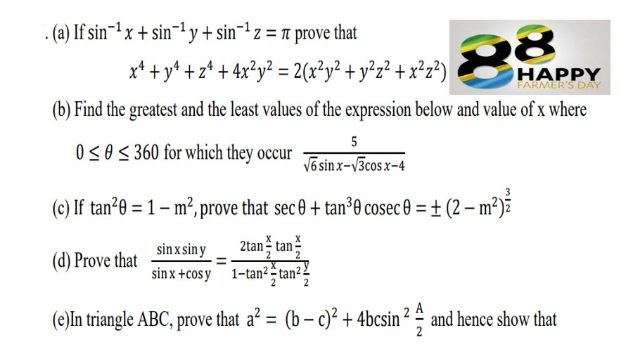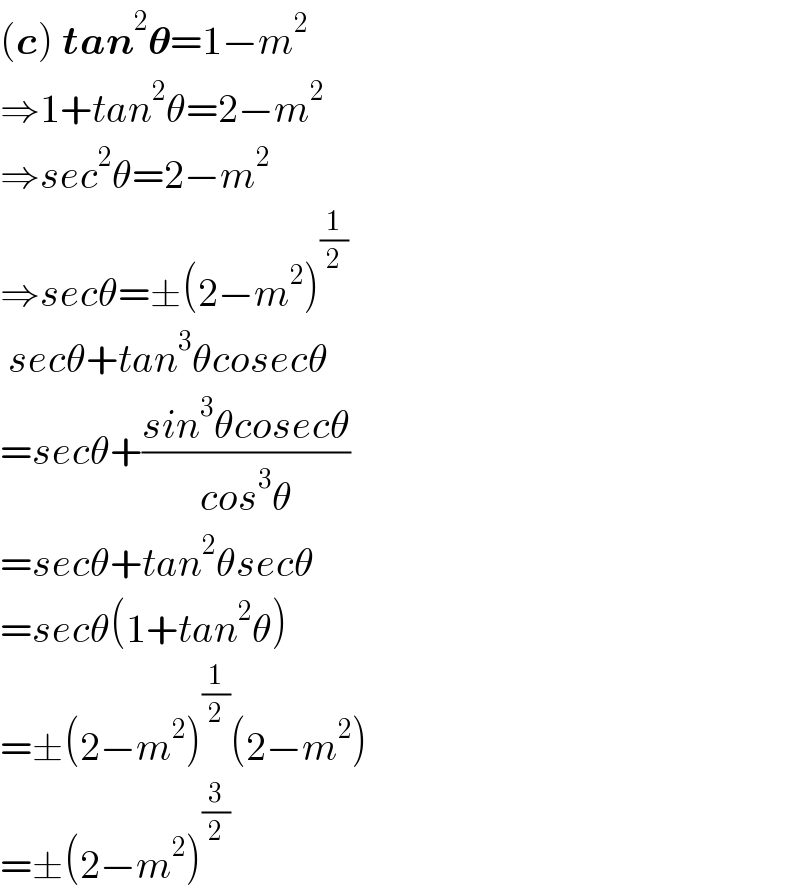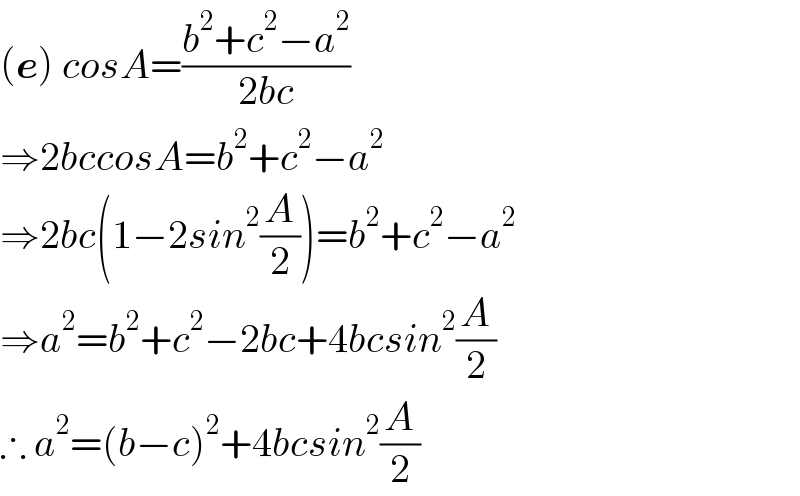
Question Number 210375 by Spillover last updated on 08/Aug/24

Commented by som(math1967) last updated on 08/Aug/24

$$\:\boldsymbol{{if}}\:\mathrm{sin}^{−\mathrm{1}} \boldsymbol{{x}}+\mathrm{sin}^{−\mathrm{1}} \boldsymbol{{y}}+\mathrm{sin}^{−\mathrm{1}} \boldsymbol{{z}}=\boldsymbol{\pi} \\ $$$${then}\:{x}^{\mathrm{4}} +{y}^{\mathrm{4}} +{z}^{\mathrm{4}} +\mathrm{4}\boldsymbol{{x}}^{\mathrm{2}} \boldsymbol{{y}}^{\mathrm{2}} \boldsymbol{{z}}^{\mathrm{2}} \\ $$$$\:=\mathrm{2}\left(\boldsymbol{{x}}^{\mathrm{2}} \boldsymbol{{y}}^{\mathrm{2}} +\boldsymbol{{y}}^{\mathrm{2}} \boldsymbol{{z}}^{\mathrm{2}} +\boldsymbol{{z}}^{\mathrm{2}} \boldsymbol{{x}}^{\mathrm{2}} \right) \\ $$
Commented by som(math1967) last updated on 08/Aug/24

$$\:\frac{{sinxsiny}}{{cosx}+{cosy}}=\frac{\mathrm{2}{tan}\frac{{x}}{\mathrm{2}}{tan}\frac{{y}}{\mathrm{2}}}{\mathrm{1}−{tan}^{\mathrm{2}} \frac{{x}}{\mathrm{2}}{tan}^{\mathrm{2}} \frac{{y}}{\mathrm{2}}} \\ $$
Commented by Spillover last updated on 08/Aug/24

$${correct}.{thank}\:{you} \\ $$
Commented by Spillover last updated on 08/Aug/24

$${correct}.{thank}\:{you} \\ $$
Answered by som(math1967) last updated on 08/Aug/24

$$\left(\boldsymbol{{c}}\right)\:\boldsymbol{{tan}}^{\mathrm{2}} \boldsymbol{\theta}=\mathrm{1}−{m}^{\mathrm{2}} \\ $$$$\Rightarrow\mathrm{1}+{tan}^{\mathrm{2}} \theta=\mathrm{2}−{m}^{\mathrm{2}} \\ $$$$\Rightarrow{sec}^{\mathrm{2}} \theta=\mathrm{2}−{m}^{\mathrm{2}} \\ $$$$\Rightarrow{sec}\theta=\pm\left(\mathrm{2}−{m}^{\mathrm{2}} \right)^{\frac{\mathrm{1}}{\mathrm{2}}} \\ $$$$\:{sec}\theta+{tan}^{\mathrm{3}} \theta{cosec}\theta \\ $$$$={sec}\theta+\frac{{sin}^{\mathrm{3}} \theta{cosec}\theta}{{cos}^{\mathrm{3}} \theta} \\ $$$$={sec}\theta+{tan}^{\mathrm{2}} \theta{sec}\theta \\ $$$$={sec}\theta\left(\mathrm{1}+{tan}^{\mathrm{2}} \theta\right) \\ $$$$=\pm\left(\mathrm{2}−{m}^{\mathrm{2}} \right)^{\frac{\mathrm{1}}{\mathrm{2}}} \left(\mathrm{2}−{m}^{\mathrm{2}} \right) \\ $$$$=\pm\left(\mathrm{2}−{m}^{\mathrm{2}} \right)^{\frac{\mathrm{3}}{\mathrm{2}}} \\ $$
Commented by Spillover last updated on 08/Aug/24

$${great}.{thanks} \\ $$
Answered by som(math1967) last updated on 08/Aug/24

$$\left(\boldsymbol{{e}}\right)\:{cosA}=\frac{{b}^{\mathrm{2}} +{c}^{\mathrm{2}} −{a}^{\mathrm{2}} }{\mathrm{2}{bc}} \\ $$$$\Rightarrow\mathrm{2}{bccosA}={b}^{\mathrm{2}} +{c}^{\mathrm{2}} −{a}^{\mathrm{2}} \\ $$$$\Rightarrow\mathrm{2}{bc}\left(\mathrm{1}−\mathrm{2}{sin}^{\mathrm{2}} \frac{{A}}{\mathrm{2}}\right)={b}^{\mathrm{2}} +{c}^{\mathrm{2}} −{a}^{\mathrm{2}} \\ $$$$\Rightarrow{a}^{\mathrm{2}} ={b}^{\mathrm{2}} +{c}^{\mathrm{2}} −\mathrm{2}{bc}+\mathrm{4}{bcsin}^{\mathrm{2}} \frac{{A}}{\mathrm{2}} \\ $$$$\therefore\:{a}^{\mathrm{2}} =\left({b}−{c}\right)^{\mathrm{2}} +\mathrm{4}{bcsin}^{\mathrm{2}} \frac{{A}}{\mathrm{2}} \\ $$
Commented by Spillover last updated on 08/Aug/24

$${great}.{thanks} \\ $$
